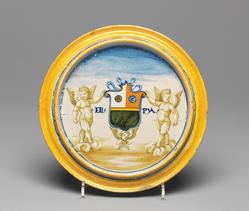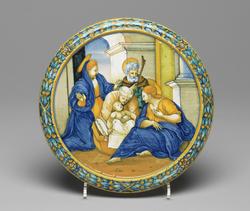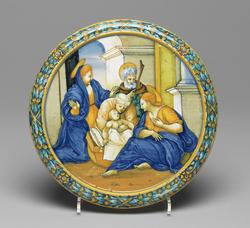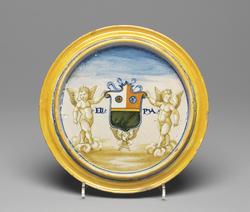Current Location: Gallery 7 (Courtauld)
Titles
The Holy Family
Maker(s)
Painter:
Milan Marsyas Painter
(Possibly)
Painter:
Xanto, Francesco
(Possibly)
Printmaker:
Caraglio, Giovanni Giacomo
(After)
Painter:
Parmigianino (Francesco Mazzola)
(After)
Entities
-
Cover
- cover from an accouchement set bowl
- tagliere
Categories
Description
Maiolica cover from an accouchement set bowl, painted in polychrome with the Holy Family.
Pale buff earthenware, tin-glazed overall. Painted in blue, turquoise-green, yellow, orange, black, grey, and white. Circular with a flange on the underside; the upper surface flat with a convex rim.
The Holy Family in an architectural setting; on the rim, bound leaves and berries between concentric yellow bands. On the back, two putti standing on clouds support a shield bearing the arms sable, a fess or, a chief party per pale gules and argent two rosettes counterchanged flanked by the letters `ELI' and `PYA'; below, a winged putto's head. The background is blue above the arms and brown below. The flange and rim are yellow.
Notes
History note: Signora Angela Beni, San Severino (Marche); given by her to Giuseppe Ranaldi (1790-1854). Alessandro Castellani; Paris, Hôtel Drouot, 28 May 1878, Catalogue des faïences italiennes . . . et de deux pièces de la célèbre porcelaine des Medicis, composant l'importante collection de M. Alessandro Castellani, lot 292; C.B. Marlay before 1887.
Legal notes
C.B. Marlay Bequest
Measurements and weight
Diameter: 19.2 cm
Height: 1.9 cm
Acquisition and important dates
Method of acquisition: Bequeathed
(1912)
by
Marlay, Charles Brinsley
Dating
16th Century, second quarter
Renaissance
Production date:
circa
AD 1531
Note
From at least the fifteenth century it was customary for a new mother to be given a little maiolica service to use for meals during her recovery after childbirth, sometimes as a gift from her husband. Childbirth, the most dangerous experience in most women’s lives, required nourishing food, like sweetmeats or broths. In Romagna and the Marches these became known as 'un servizio da impagliata' because the word 'impagliata' was used to describe a woman during her lying-in. According to Cipriano Piccolpasso (c. 1523/4-79) in I tre libri del Arte del Vasaio, written about 1557, the services usually had five pieces arranged on top of each other: a standing bowl covered by a plate, a drinking bowl on a foot, and a salt and its cover.
These sets are mentioned in many fifteenth and sixteenth century inventories but apart from a salt in the Victoria and Albert Museum, only bowls and covers appear to have survived. Most of them are decorated with scenes of childbirth, the washing of babies, or women with small children. Others have childbirth scenes from the Bible or classical mythology, or subjects connected with qualities, such as valour, which it was hoped the child would acquire.
The Holy Family on the top of this cover was derived from the 'Adoration of the Shepherds', engraved by Giovanni Giacomo Caraglio after Parmigianino (1503-40). It shows the Virgin Mary, Joseph and a female saint, around the new-born baby Jesus, who is cradled in the arms of a woman who has no halo, and was perhaps a midwife. The scene was intended to inspire the new mother, who would have looked to the Virgin and St Anne as models of motherhood. The reverse is painted with two putti, the family’s coat-of- arms, and the initials, ‘ELI’ and ‘PYA’, said to be for the name of the father, ‘Elisio Piani’, an official of the Monte Pietà in Urbino in early sixteenth-century Urbino. A dish painted with the 'Judgement of Paris' by Francesco Xanto in 1531 bears the same coat-of-arms (Fitzwilliam Museum, C.86-1961).
If not painted by the 'Milan Marsyas Painter' this cover was probably painted by Francesco Xanto Avelli da Rovigo
School or Style
Renaissance
People, subjects and objects depicted
Components of the work
Decoration
composed of
high-temperature colours
( blue, turquoise-green, yellow, orange, black, grey, and white)
Materials used in production
Tin-glaze
Earthenware
Techniques used in production
Tin-glazing
: Pale buff earthenware, tin-glazed overall, and painted in blue, turquoise-green, yellow, orange, black, grey, and white.
Inscription or legends present
Inscription present: I smaller than L and Y and A joined
- Text: ELI PYA
- Location: On back flanking arms
- Type: Inscription
References and bibliographic entries
Related exhibitions
Identification numbers
Accession number: MAR.C.60-1912
Primary reference Number: 77384
Stable URI
Audit data
Created: Saturday 6 August 2011
Updated: Tuesday 16 September 2025
Last processed: Tuesday 16 September 2025
Associated departments & institutions
Owner or interested party:
The Fitzwilliam Museum
Associated department:
Applied Arts
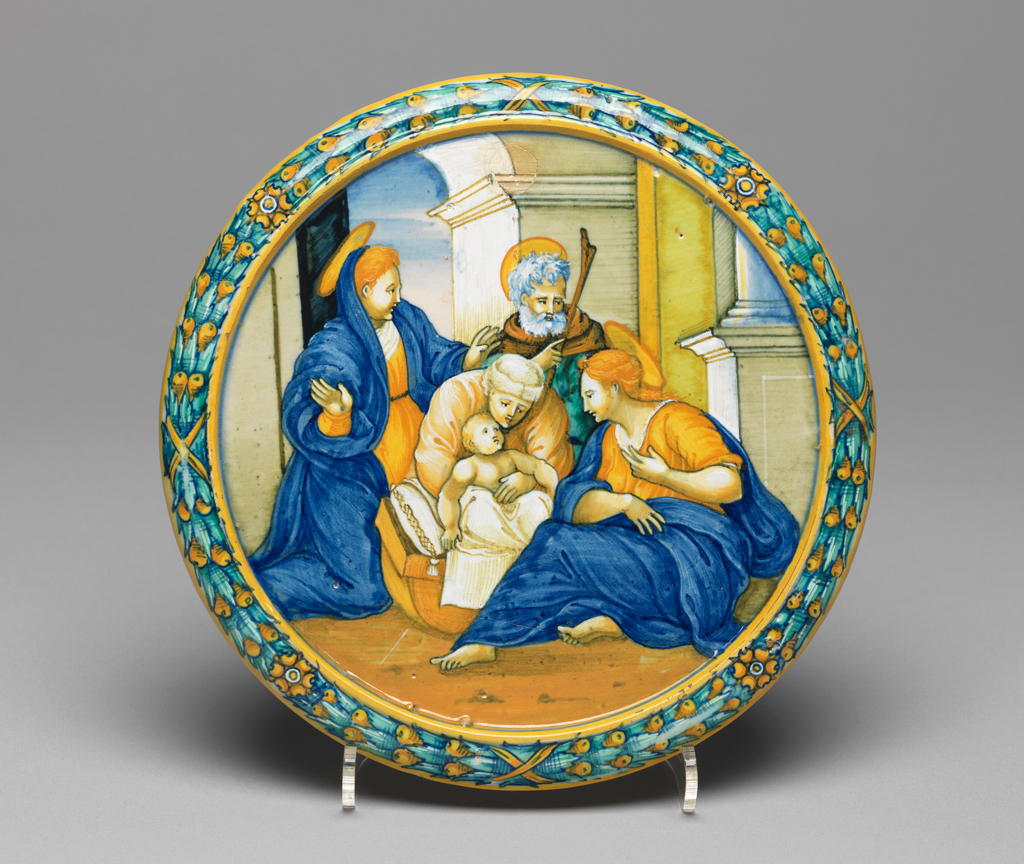
 IIIF Manifest
IIIF Manifest
